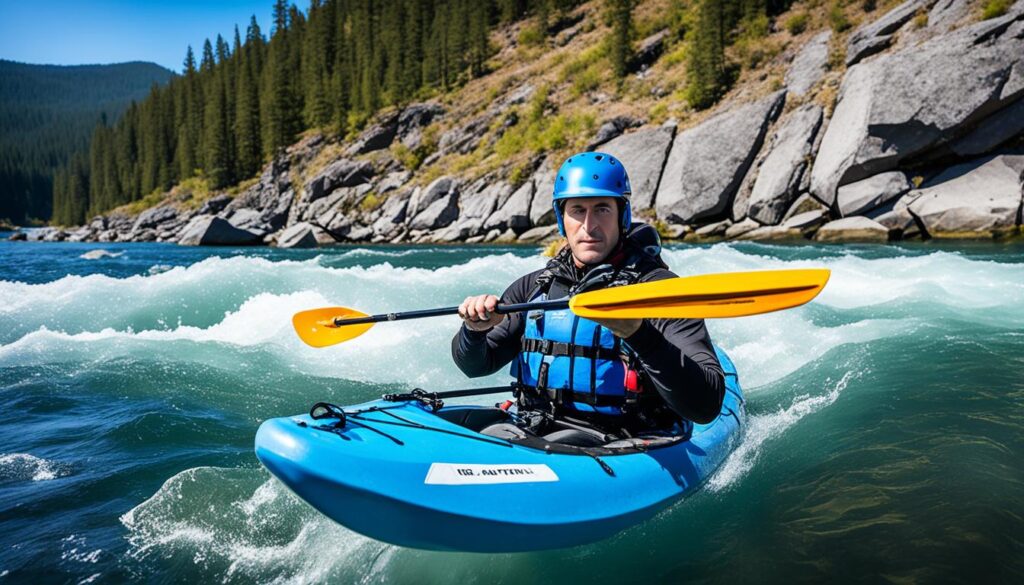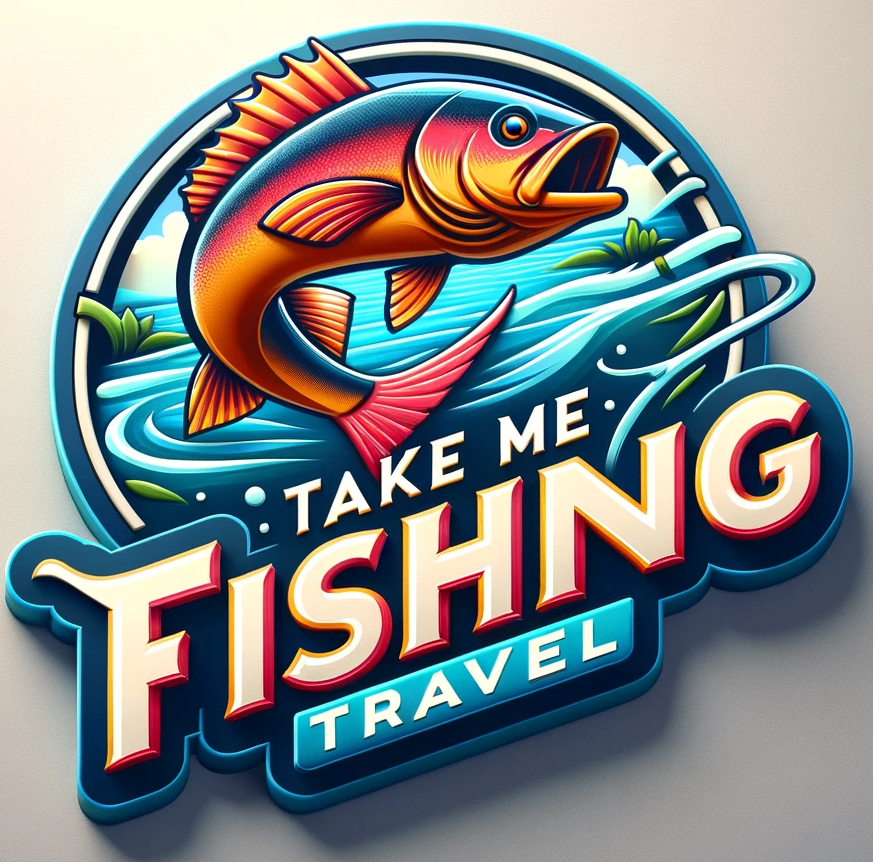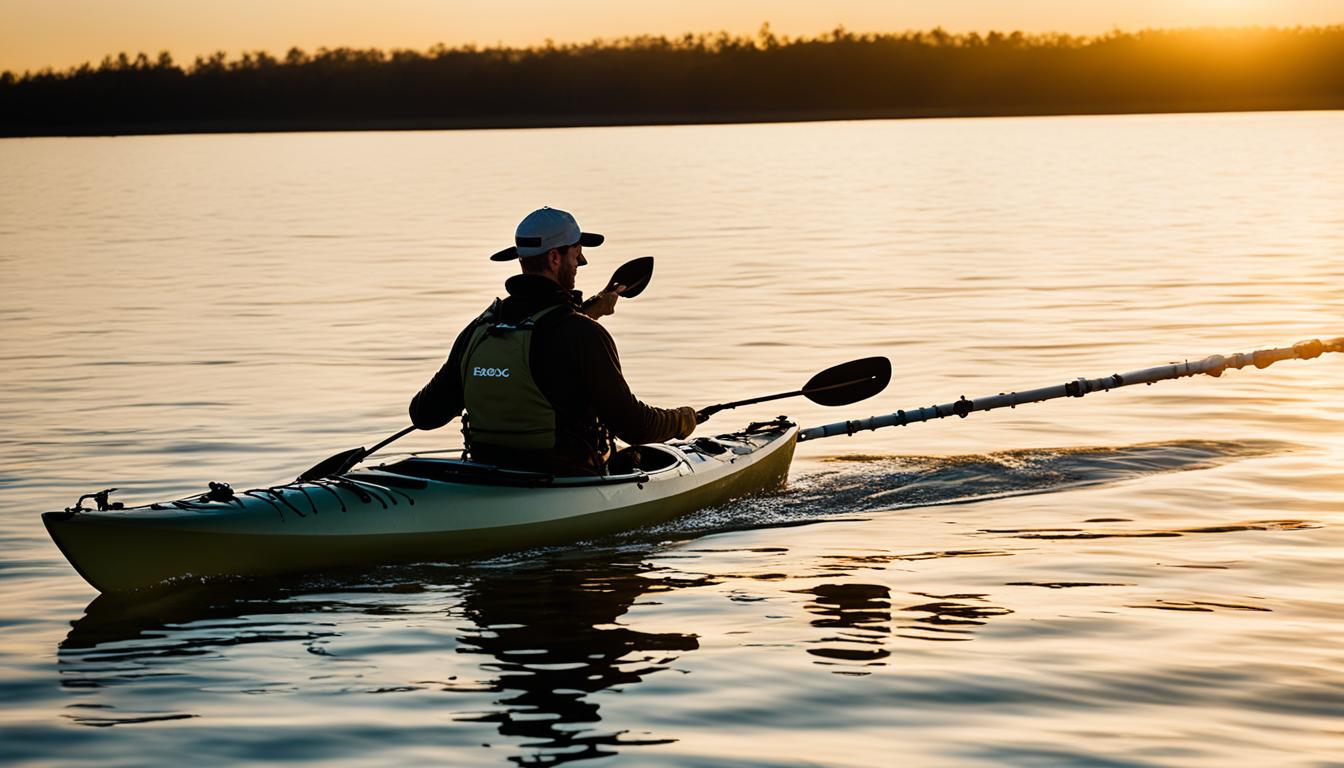This post contains affiliate links.
Feel the gentle bump of water against your kayak as you wait for the fish to bite. This is kayak fishing, and for over 20 years, it’s been changing the game. An angler found this quiet, nature-friendly way to fish in the hidden places of the world. Since then, we’ve been finding new ways to catch fish and reach secret fishing spots.
Picture yourself on a small, calm lake. You’re casting into spots where big fish hide, places that big boats can’t get to. Imagine paddling down a thin stream, getting up close to shy trout. Kayak fishing is all about getting in touch with nature like never before. And today, there’s a kayak for every fishing adventure out there, with loads of special gear available.
Key Takeaways
- Kayak fishing gives you access to waters that are hard to reach by big boats.
- There’s a wide range of kayaks made just for fishing, meeting different fishing needs.
- Kayak fishing safety is crucial, so always wear a life jacket and keep your gear safe.
- Learning kayak fishing techniques like casting with one hand and controlling the kayak with your feet can change your fishing game.
- Kayaks let you explore unique fishing spots, like shallow, hidden waters.
This guide is perfect whether you’re just starting out or you’re already a fishing pro. It will help you have great times on the water. So, grab your fishing rod, get the right kayak fishing gear, and prepare for a new fishing adventure.
Introduction to Kayak Fishing
Kayak fishing has changed how people fish. It lets anglers get to places that are hard to reach by other boats. This sport lets you be close to nature and sneak up on fish quietly.
Benefits of Kayak Fishing
Kayak fishing is great for exploring hidden spots like secluded coves and narrow inlets. Because kayaks are small and quiet, you won’t scare the fish. This makes angling from kayaks more successful.
Kayaks also give you a better view of marine life. Imagine targeting bass in a peaceful lake. Or, chasing redfish in the marshes. These kayak fishing destinations are full of adventure and peace.
The Rise of Kayak Angling
In the last 20 years, kayak angling adventures have become very popular. They are particularly loved by those looking for a cheaper way to fish. The low cost and the ease of moving kayaks have helped make this sport grow.
The sport has also gotten better with special gear for kayak fishing. Things like rod holders and fish finders make fishing from kayaks better. With the increasing interest, kayak makers are creating more designs for fishermen. This shows how much kayak fishing has become a big part of fishing.
Essential Safety Tips for Kayak Anglers
When kayak fishing, staying safe is the most important thing. The peaceful water can turn risky fast. Follow these key kayak fishing safety tips for worry-free fishing.
Dress for the Water
Wear clothes that keep you warm and dry. Choose according to the water’s temp and the day’s weather. Always wear a Personal Flotation Device (PFD) when you’re on the water.
Secure Your Gear
Tie down your kayak angler equipment so it won’t fall in the water. Keep your kayak neat to avoid tipping and to make sure your gear doesn’t become a danger.

Maintain Your Center of Balance
Stay balanced on the water by keeping your body in the middle of the kayak. Avoid quick moves that can tip you over. Learn kayak fishing techniques like how to cast and paddle with one hand for better balance.
Here are some extra safety tips to remember:
- Always carry a VHF Marine Radio for help if you need it.
- Have a safety kit with a whistle, compass, bilge pump, knife, pliers, and gloves.
- Tell someone where you’re fishing and when you plan to come back.
- Bring a GPS or compass to keep your direction clear in bad weather or fog.
- Fish with friends who know how to stay safe on the water.
Safety comes first in kayak fishing. It lets you enjoy the excitement while cutting down on dangers. This way, you have a great time out on the water.
Choosing the Right Kayak for Fishing
The popularity of kayak fishing has flooded the market with various options. Choosing the right one is key to a good fishing experience. Kayak models are now made especially for angling from kayaks.
Factors to Consider
When looking at kayak angler equipment, think about your needs. It’s important to match the kayak to your body size for a comfortable fit. Trying before buying ensures it feels right for you.
Kayak Length and Stability
Kayak length and its stability are vital. Long kayaks from 10 to 12 feet are typically more stable and track better. They’re good for angling from kayaks as they let you stand and cast easily, and have more storage.
Shorter kayaks are better if you need to move through tight spots. They are more nimble but may not be as stable in rough waters.
| Kayak Type | Advantages | Disadvantages |
|---|---|---|
| Sit-on-Top | Stable, easy entry/exit, gear storage | Limited insulation, less efficient paddling |
| Sit-Inside | More efficient paddling, better insulation | Less stable, limited movement |
| Pedal-Powered | Hands-free fishing, increased mobility | More expensive, additional maintenance |
| Inflatable | Highly portable, durable construction | Potential performance limitations |
Look for rod holders, comfy seats, and storage. Features like gear tracks and a motor drive can make kayak fishing even better. They free you to enjoy the excitement of fishing.
Must-Have Accessories for Kayak Fishing
Getting the right kayak angler equipment is key to a great time on the water. Items like paddles and PFDs are crucial for safety and fun while kayak fishing.
Selecting the Perfect Paddle
A good paddle is essential for any kayak angler. Consider a longer paddle, around 230 to 260 cm, for better reach and less tiredness. The type of material and blade size are also important.
| Paddle Model | Length | Price |
|---|---|---|
| Solstice 4-piece Quick Release Paddle | Adjustable | $49 |
| Kokopelli Alpine Lake 4-Piece Paddle | Adjustable | $124.95 |
| NuCanoe Aluminum Wave Paddle | 230 cm | $95 |
| Feelfree Camo Series Angler Paddle | 230 cm | $99 |
| Old Town Carlisle Magic Angler Paddle | 244 cm | $129 |
| Bending Branches Angler Scout Paddle | 244 cm | $129 |
Importance of a Quality PFD
Kayak fishing safety is critical, and a good PFD is necessary. Look for a PFD that fits well and has pockets for storing small items.

| PFD Model | Type | Price |
|---|---|---|
| NRS Chinook Fishing Life Jacket | Vest | $119.95 |
| NRS Women’s Shenook Fishing PFD | Vest | $119.95 |
| Old Town Lure II Angler PFD | Vest | $139.99 |
| NRS Matik Inflatable PFD | Inflatable | $142.50 |
Launching and Loading Your Kayak
Before you start your kayak fishing trips, learn how to launch and load your kayak. Public boat ramps are easy to use but they can harm your kayak. If you want to reach quiet waters, look for secret launch spots.
Launching stern-first from the shore can stop your kayak from turning over. It might be tricky at first, but it keeps you dry at the start of your journey.
Loading systems and helpers make transporting kayaks much easier, especially for heavier models.
For carrying your kayak on a car, look at brands like Yakima, Thule, and Malone for your kayak roof rack. Thule has the Hullivator, which costs $589.95. It helps lift kayaks up to 40lbs, making it easier to load.
- When loading two kayaks on bars, you may need more space for straps. This could mean you need extra clamps for them.
- Options like Thule Stackers, Hull-a-Port carriers, Yakima Bowdown, Hullraiser, or Malone J-Loader help save space on your car’s roof. They are great for lighter kayaks.
- Loading heavier kayaks on their side might need two people. But, one person can often handle lighter ones.
Looking for a do-it-yourself approach? You can find creative kayak rack ideas online. Sites like YouTube have plenty of designs to check out.
| Brand | Product | Weight Capacity | Price |
|---|---|---|---|
| Thule | Hullivator | 40 lbs | $589.95 |
| Yakima | Bowdown | 35 lbs | $249.99 |
| Malone | J-Loader | 45 lbs | $149.99 |
Kayak Fishing Techniques for Bass
Choosing the right lures and skills is vital when fishing for bass in a kayak. It’s important to use the strategies that work best in small waters. Begin with essential gear like a single rod and bait that bass love, such as Texas-rigged worms and topwater poppers.
Casting and Presenting Lures
A kayak’s low view means you’ll need to be sneaky when casting your lures. Try out lures like Texas-rigged worms, jerkbaits, and poppers. Fishing along banks hit by the breeze can help. Cast with the wind to cover more ground.
Fighting and Landing Fish
Catching bass from a kayak is thrilling, just above the water. Be ready to pull in the fish with a net or your hand. Use quick lures on windy days and slower ones when it’s sunny.
Drift fishing is a smart way to catch more fish. It lets you move and fish at the same time. You can also use many boat fishing tricks in a kayak, including careful and direct ways to present your bait.
| Popular Kayak Bass Lures | Ideal Conditions |
|---|---|
| Texas-rigged worm | Calm waters |
| Ned Rig | Clear water, sparse cover |
| Spinnerbait | Windy conditions, cover |
| Jig & Trailer | Vertical presentation, thick cover |
| Crankbait | Shallow water, cover |
Kayak Fishing for Other Species
Kayak fishing isn’t just about catching bass. It lets you explore hidden waters where all kinds of fish live. You might cast for trout in a mountain stream, track redfish in the flats, or look for panfish in ponds. Kayaks give anglers tons of options.
To catch different fish, you need different tools and tricks. For pickerel in millponds in winter, try using spinners, jerk baits, or minnows with a bobber. These are good along the shore or in the middle of the pond. Trying to catch white perch in deep water? Use small metal jigs and jig slowly on quiet days.
For crappie, try deep water in reservoirs with colorful micro-jigs. This often works. And if you’re after a variety of fish, using live bait can be a fun way to get bass, catfish, and more.
| Species | Recommended Gear | Techniques |
|---|---|---|
| Trout | Lightweight spinning rod, small spinners, nymphs | Drift fishing, upstream presentations |
| Redfish | Medium-heavy baitcasting rod, topwater plugs, spoons | Sight casting, working shorelines |
| Panfish | Ultralight spinning rod, small jigs, live bait | Vertical jigging, slip-bobber fishing |
For any fish you aim to catch, the key is often small, delicate gear and being quiet. A short, flexible rod and light line for live bait are great. Learn to tie strong knots to keep your best catches. Always check your fishing line, and take care when hooking fish.
If you’re not going to eat the fish, it’s best to release them back into the water. But if you do keep some for eating, choose them wisely. Go for the smallest bass, bluegill, and crappies. This way, you help keep the fishing areas full of fish.
Mastering Kayak Control and Maneuverability
To fish effectively from a kayak, you need to perfect one-handed casting and paddling. These skills ensure your kayak stays steady. They help you fish without scaring away your target.
One-Handed Casting and Paddling
Work on casting with one hand and using the other to move your kayak. It might take some practice. But learning this technique is key for staying in control and exploring more fishing spots.
Using Your Feet for Steering
Skilled kayak anglers use their feet to steer accurately and stay still in shallow waters. By dragging your feet lightly, you can adjust your kayak’s course without paddling hard. This helps you stay quiet when fishing in small spaces.
Utilizing Currents and Eddies
Instead of battling strong currents, use them to your advantage. Letting currents carry you can get you to the best fishing spots. Eddies, on the other hand, are calm areas where you can cast freely.
Getting good at these kayak fishing tricks and adjustments will up your fishing game. It makes you a better angler, improving your kayak experience. You’ll have better control, stability, and be more agile on the water.
Advanced Kayak Fishing Strategies
As you get better at kayak fishing, you’ll learn tricks to make it more fun. Using the right gear and fishing near the shore are two smart moves. They help you make the most of your time on the water and find new places to fish.
Anchoring Techniques
Anchors keep your kayak steady which is great when there’s wind or strong currents. You can cast your line without moving too far. For fishing in rivers, using an anchor trolley is smart. It lets you drop or pull your anchor back fast when the water’s moving.
Shoreline Fishing
Kayaks can go where big boats can’t, right up close to the shore. This makes it easy to fish in very shallow spots. It’s also a good way to avoid strong winds and waves.
Using the right tools and skills in your kayak makes fishing better. Whether you’re staying still to fish the deep spots or moving quietly to catch fish near the shore, you’ll improve your fishing trips a lot.
| Anchoring Advantages | Shoreline Fishing Benefits |
|---|---|
| Stay on productive spots | Access ultra-shallow areas |
| Work a spot thoroughly | Reduced paddling effort |
| Hold position in wind/current | Better wind/wave protection |
Kayak Fishing Safety and Regulations
When you go out on your kayak to fish, always think about safety first. It’s important to know the rules and be careful to have fun safely.
Make sure you have the right safety equipment. A life jacket or personal flotation device (PFD) is a must. It can save you if you fall in the water.
Check the weather before you leave for your kayak fishing trip. Weather can change suddenly, turning a calm day dangerous.
Remember to watch out for boats and know the water rules. Choose where you paddle carefully.
Staying hydrated and eating right is very important. It keeps you strong and focused so you can have a great time safely.
- Learn how to get back in your kayak if you fall out.
- Don’t drink too much alcohol when you’re being active on the water.
- Use things like maps and compasses to navigate safely through new places.
- Bring sunblock, sunglasses, bug spray, and a first aid kit with you.
By thinking about safety and knowing the rules, you can have a safe and fun time kayak fishing. Enjoy your time on the water knowing you’re well-prepared.
Conclusion
Kayak fishing is an exciting way to catch fish. It allows you to fish in places that are hard to reach by boat. You get a chance to catch more fish in these spots because fewer people fish there.
This sport is also great for your health. It gives you exercise and helps you relax in nature’s quiet. To start, learn the basic fishing skills and make sure you have the right gear and safety equipment.
Having a kayak that fits your needs is important. It lets you fish comfortably for a long time. You can make your kayak better by adding things like rod holders and extra storage. This helps you have a great fishing experience.
With kayak fishing, you get close to nature while doing what you love. You can paddle in calm lakes, explore rivers, or go out to sea. Meeting other kayak anglers can be fun too. You can share tips and stories with them.
This sport is good for the environment and your wallet. It’s a chance to see the natural world from a different perspective. So, start kayak fishing and see where it takes you. It opens up an exciting new world for fishing fans.
FAQ
What are the benefits of kayak fishing?
How can I stay safe while kayak fishing?
What factors should I consider when choosing a fishing kayak?
What accessories are must-haves for kayak fishing?
How can I improve my kayak fishing techniques?
What are some advanced kayak fishing strategies?
How can I stay safe while kayak fishing?
This post contains affiliate links.

